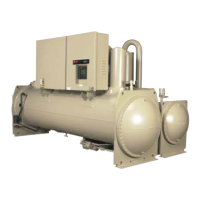RTHD-SVX01D-EN 75
Operating Principles Mechanical
This section contains an overview of the operation and maintenance of Series
R chillers equipped with microcomputer-based control systems. It describes
the overall operating principles of the RTHD water chiller..
Following the section is information regarding specific operating instructions,
detailed descriptions of the unit controls and options (Operator Interface -
Control Systems), and maintenance procedures that must be performed reg-
ularly to keep the unit in top condition (Periodic Maintenance and Mainte-
nance Procedures). Diagnostic information (Diagnostics) is provided to allow
the operator to identify system malfunctions.
NOTE: To ensure proper diagnosis and repair, contact a qualified service
organization if a problem should occur.
General
The Model RTHD units are single-compressor water-cooled liquid chillers.
These units are equipped with unit-mounted starter/control panels.
The basic components of an RTHD unit are:
• Unit-mounted panel containing starter and TracerCH530 controller and
Input/Output LLIDS
• Helical-rotary compressor
• Evaporator
• Electronic expansion valve
• Water-cooled condenser with integral subcooler
• Oil supply system
• Oil cooler (application dependent)
• Related interconnecting piping.
Refrigeration (Cooling) Cycle
The refrigeration cycle of the Series R chiller is conceptually similar to that of
other Trane chiller products. It makes use of a shell-and-tube evaporator
design with refrigerant evaporating on the shell side and water flowing inside
tubes having enhanced surfaces.
The compressor is a twin-rotor helical rotary type. It uses a suction gas-
cooled motor that operates at lower motor temperatures under continuous
full and part load operating conditions. An oil management system provides
an almost oil-free refrigerant to the shells to maximize heat transfer perfor-
mance, while providing lubrication and rotor sealing to the compressor. The
lubrication system ensures long compressor life and contributes to quiet
operation.
Condensing is accomplished in a shell-and-tube heat exchanger where refrig-
erant is condensed on the shell side and water flows internally in the tubes.
Refrigerant is metered through the flow system using an electronic expan-
sion valve, that maximizes chiller efficiency at part load.
A unit-mounted starter and control panel is provided on every chiller. Micro-
processor-based unit control modules (Tracer CH530) provide for accurate
chilled water control as well as monitoring, protection and adaptive limit func-
tions. The “adaptive” nature of the controls intelligently prevents the chiller
from operating outside of its limits, or compensates for unusual operating
conditions, while keeping the chiller running rather than simply tripping due to
a safety concern. When problems do occur, diagnostic messages assist the
operator in troubleshooting.

